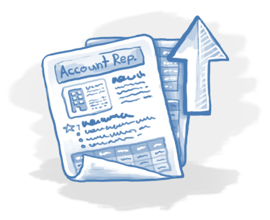Sales force performance is obviously of vital inte rest to any company.
rest to any company.
Here are 4 key elements for ensuring your salespeople are selling at their optimal levels and constantly improving. While some of these may seem like “givens” and be taken for granted, it is worth examining your sales force newly with these factors in mind; you may be surprised at what you find.
#1: Full Knowledge of Product or Service
Does your sales force fully understand the products and/or services they are selling?
You may have already discovered how important this actually is—reps who understand their product through-and-through are nearly always the better performing salespeople.
It’s not just so they can rapidly and confidently answer questions about the product, although that is certainly important. The main reason you want a salesperson to achieve this understanding is so that they can clearly communicate the benefits of the product or service to a prospect, with that prospect’s particular issues in mind. If a rep doesn’t fully understand the product, promises can be made that your company cannot deliver on, or other errors can occur which result in lost sales or dissatisfied customers.
This of course goes hand-in-hand with #2 below.
#2: Comprehensive Knowledge of Buyers
Who exactly is your sales rep selling to? What particular issues does the prospect company encounter? What does the prospect’s overall industry or segment look like with respect to what your sales rep is selling?
Answers to questions such as these are not only vital for your sales force, but to the marketing and promotional efforts of your company as well. It should be made a company priority to research this kind of data and keep it updated. Sales reps and any employees who deal with the public should be constantly informed regarding what makes up that public, what motivates them, and what problems they are trying to solve.
In the days before the internet, such information was hard-won and much of the time only acquired through trial-and-error. Today, however, such data can be easily researched online—and should be.
It is also vital to know the buying patterns of your prospects and customers, so that you can pattern your sales processes (and actions of your sales force) to reflect them. The sales process dovetails right into our next key element.
#3: CRM Solution for the Sales Force
It is true that the vast majority of companies have CRM solutions in place. Unfortunately it is also true that most sales reps are not happy with the CRM solutions with which they are forced to interact, and only do so begrudgingly.
The main problem with such CRM solutions has to do with the fact that they were primarily designed to be a tool for the coordination and synchronization of all company activities with regard to customers. Left out of this equation, however, was the fact that the primary front line of “customer relationship management” is the sales force. A CRM solution should therefore be an empowering and supporting agent for sales reps.
With CRM alone, a sales rep should be able to clearly view the status, priority and potential of each of his or her sales, along with all pertinent data about the prospect. Analysis and forecasting should be able to be accomplished with a minimum of effort and time—sales reps perform best when they are allowed to sell and not spend inordinate amounts of time being data entry clerks or having to create reports.
To meet these qualifications, a CRM solution should be patterned to reflect the company’s sales process. It will be found that such patterning not only greatly facilitates sales force use of CRM, but use by everyone else in the company as well.
#4: Continuously Improved Sales Technique
While stated last, this is certainly not least. In many companies this is probably the weakest of these 4 key elements, but is likely the most important.
Most if not all sales reps go through a training period, either early in their careers or with each company for whom they go to work, or both. But then they embark on their jobs and never look back—due to becoming busy, meeting quotas and many other factors, they stop learning and improving their skills.
With a “peak” of ability reached, each rep has his or her closing ratio, and that ratio is likely to remain relatively unchanged. The closing ratios for individual sales reps add up to the average closing ratio for the entire sales force. When salespeople are not having their skills regularly improved, the average closing ratio for the company is not improving, either.
Conversely, if regular enhancement of sales competence is being made part and parcel of sales rep activity, each of those closing ratios is becoming better. And so is that average. And so is the ability of your sales force—and therefore your entire enterprise—to meet and exceed its sales forecasts.
See to the full application of these 4 key elements of sales force performance—and see to the overall improved performance of your company as well.
Look for our other articles on improving sales force skill.





















